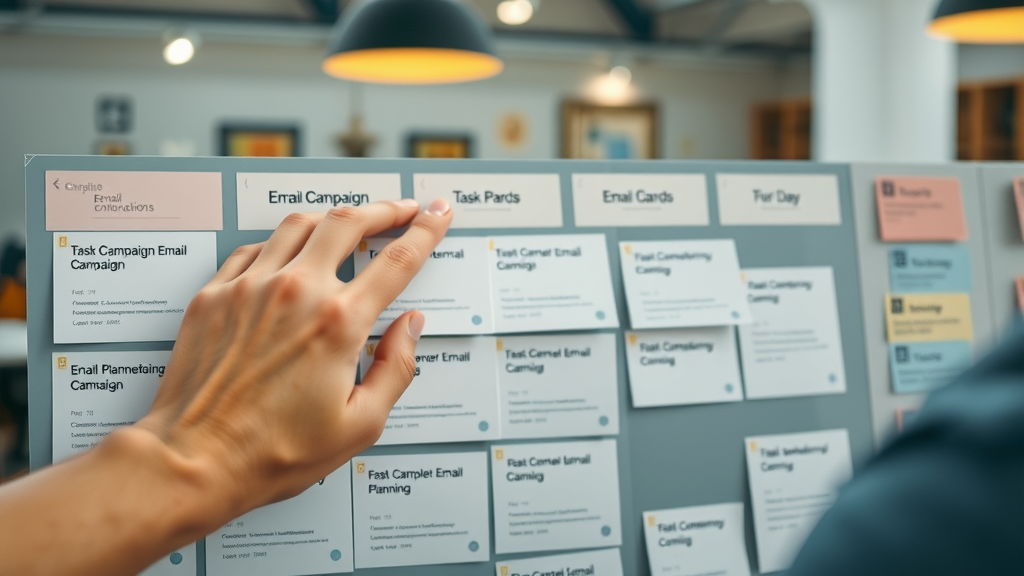Did you know that email marketing delivers an astonishing 4200% ROI for every dollar spent? That’s enough to capture any marketer’s attention. But those numbers aren’t automatic—mastering email marketing best practices is your ticket to transforming mediocre email campaigns into powerful, profit-driving assets. Whether you want to increase open rates, avoid the spam folder, or build lasting engagement, this comprehensive guide reveals the strategies you simply can’t afford to ignore.
Why Email Marketing Best Practices Are More Crucial Than Ever
- Did you know that email marketing boasts a 4200% ROI for every $1 spent? Discover why following current email marketing best practices can make or break your email market success.

The State of the Email Market in 2024
The landscape of the email market has evolved rapidly in recent years. In 2024, inboxes are more competitive than ever, with consumers receiving dozens (sometimes hundreds) of messages daily. The technology powering email marketing campaigns continues to mature, making advanced targeting, automation, and personalization accessible even to small businesses. Understanding the trends that shape this market—such as AI-driven segmentation, privacy laws, and user preference shifts—is essential for email marketers who want to stand out.
A crowded inbox doesn’t mean opportunity is lost. In fact, those who adapt to marketing best practices enjoy better open rates , higher engagement, and lower unsubscribe rates. Brands investing in optimized email design and content targeting are seeing their email campaigns outperform less agile competitors. The bottom line? Staying current amidst constant change can pave the way for a successful email marketing strategy.
How Email Marketing Best Practices Drive Superior Results
When you implement proven email marketing best practices , your campaigns benefit from enhanced relevance and deliverability. Everything from cultivating a clean email list to using data-driven subject lines contributes directly to better performance. For instance, segmented campaigns average a 14.3% higher open rate and more conversions—a number impossible to ignore if you are measuring ROI.
Consistently applying best practices also future-proofs your marketing efforts. It means you’re ready to pivot as algorithms and consumer behaviors shift. The brands consistently following best practices don’t just get better numbers; they build authentic connections and trust with their subscribers. This is the difference between an inboxed email and a deleted one.
Common Pitfalls When Ignoring Email Marketing Best Practice Principles
Overlooking email marketing best practices sets your campaigns up for disappointment. From ending up in the spam folder to watching your email list shrink with every send, common missteps can be devastating. One major pitfall is neglecting email list hygiene ; using outdated or purchased lists means lower deliverability and higher bounce rates.
Weak subject lines and bland email content often result in dismal open rates and dwindling audience engagement. Worse, failing to optimize for mobile devices or ignoring evolving compliance regulations can damage your sender reputation and lead to blacklisting by service providers. The lesson? Respecting best practice principles is more than a suggestion—it’s a necessity for any serious email marketer.
Essential Elements of Successful Email Marketing Best Practices
- Understand the foundational marketing best practices that elevate effective email campaigns and create lasting impact in your overall marketing strategy.
Email List Hygiene: How to Maintain and Grow Quality Email Addresses

Successful email marketing best practices start with a healthy email list. This means consistently scrubbing out invalid, duplicate, or disengaged email addresses to protect your sender score and improve deliverability. Employing double opt-ins, updating preferences, and regularly running email verification are all critical steps. The result? You keep your email list both potent and engaged, driving higher open and click-through rates.
Growth shouldn’t come at the expense of quality. Rather than buying lists, focus on building an audience organically through compelling lead magnets, engaging website forms, and exclusive offers. Continual list maintenance not only cuts costs by removing non-responsive entries—it signals to service providers that your campaigns are trustworthy, which helps keep you out of the spam folder.
Crafting Compelling Subject Lines That Increase Open Rates
Your subject line serves as the “gatekeeper” of your email campaign . Poorly written or generic subject lines get ignored, while personalized, curiosity-driven ones boost open rates dramatically. A/B testing, emotional hooks, and urgency cues are your best tools for finding winning formulas. Data shows that subject lines under 50 characters, with clear value propositions and a personal touch, are most successful.
Remember: Subject lines are extensions of your brand’s voice. Tailor them to your target audience using segmentation and previous engagement metrics. By doing so, every subject line feels like it was crafted just for the recipient, prompting more consistent engagement and building anticipation for future emails.
Building High-Converting Email Content for Your Email Campaign

Once your email is opened, compelling email content is what drives readers to action. Start with a warm, relevant introduction tied directly to your subject line . Use concise copy, strong visual hierarchy, and clear calls to action (CTAs). Bullet points and short paragraphs make content scannable, which is essential for busy readers.
Personalization is another game-changer. Referencing the recipient’s name, purchase history, or preferences in your email content increases relevance and click-through rates. Always align content with the campaign’s objective, whether to promote a new product, educate with valuable insights, or inspire readers to visit your landing page .
The Role of Personalization for a Successful Email Marketing Campaign
Personalization reigns supreme in modern email marketing best practice . Beyond “Hello, [Name],” robust personalization leverages behavioral data, purchase history, and even browsing habits to craft hyper-relevant messaging. This strategy moves potential customers through your funnel faster by making every email campaign feel tailored and timely.
Marketers who use personalized fields and dynamic content blocks see measurable boosts in both engagement and sales. Sending the right message to the right segment, at the optimal moment, transforms a generic campaign into a successful email marketing experience that keeps subscribers coming back for more.
Segmentation: Refining Your Email Marketing Strategy for Better Engagement
Segmentation is the practice of dividing your email list into target groups based on demographics, interests, behaviors, or purchase activity. By customizing your messaging for each audience segment, you drastically increase the likelihood of resonance and conversion. Thoughtful segmentation supports every aspect of your email marketing strategy .
For example, a clothing retailer might segment audiences by gender or location to spotlight relevant deals. Segmenting by engagement level lets you send reactivation campaigns to at-risk subscribers, while rewarding loyal customers with special offers. As a result, segmented email campaigns routinely outperform those using mass-blast tactics.
Ensuring Mobile Device Optimization in Email Design

More than half of all emails are now opened on a mobile device . This makes mobile optimization a non-negotiable element of email design . Mobile-friendly emails load quickly, feature touch-friendly buttons, and use a single-column layout with large font sizes for readability on any screen.
Test every email template across devices before deploying your campaign, checking for images, CTAs, and formatting issues. Responsive design not only enhances user experience but also signals quality to service providers—further protecting you from ending up in the spam folder. Failure to optimize costs you opens and clicks, especially among younger, mobile-first audiences.
Avoiding the Spam Folder: Technical Email Marketing Best Practice
Landing in the spam folder is a nightmare for any email marketer . Key technical “must-dos” include authenticating your domain (using SPF, DKIM, and DMARC), avoiding spammy wording, and monitoring blacklists. Using double opt-in, honoring unsubscribes, and maintaining proper HTML-to-text ratios in email design are all critical to deliverability.
Regularly update your email list to remove inactive contacts and check for spam traps. Additionally, only work with reputable service providers and ensure your physical business address appears in every footer, as required by regulations. Meticulously following these marketing best practices is the surest way to stay visible and trusted in your subscribers’ inboxes.
What You'll Gain by Mastering Email Marketing Best Practices
- Acquire practical tools and insights to implement top-tier marketing best practices, enhance your next email market campaign, and become a savvy email marketer.
Why Every Email Marketer Should Track Metrics and Analytics
Without reliable analytics, it’s impossible to know if your email marketing best practices are effective. Identifying trends in metrics like open rate , click-through rate, and bounce rate allows you to adjust your approach in real-time, eliminating guesswork. Metrics reveal where your campaigns are strongest and where you’re losing engagement.
Investing in an analytics-savvy marketing strategy empowers you to optimize each campaign for better ROI. Set clear goals, track every send, and let the data drive your next move. An analytical edge transforms you from a sender to a strategic email marketer capable of sustained success.
Elevating Customer Engagement Through Advanced Email Marketing Campaign Tactics

Advanced tactics like gamified content, dynamic product recommendations, and interactive surveys can delight your subscribers and drive higher engagement rates. The key is consistently delivering value—whether through targeted discounts, first-to-know announcements, or exclusive event invites.
Deepening engagement also involves smart automation. Automated email campaigns triggered by user behavior (abandon carts, browse follow-ups) keep your brand top-of-mind and build a loyal audience. Well-executed engagement tactics ensure each email campaign stands out in a crowded market.
How Automated Email Sequences Can Scale Results
Automated email sequences—like welcome drips, abandoned cart reminders, and re-engagement series—help scale your efforts without diluting personalization. Automation frees you from manual tasks and ensures timely, relevant touchpoints for every subscriber, even as your email list grows.
By integrating segmented workflows, conditional logic, and dynamic content, automation not only saves time but boosts both conversion and retention. Today’s top-performing marketers combine intelligent automation with regular performance reviews, continually testing and refining their campaigns for optimal results.
- Checklist: Top 10 Email Marketing Best Practices for 2024
- Start with a verified, engaged email list .
- Craft clear, curiosity-driven subject lines .
- Personalize content at every opportunity.
- Segment your audience for targeted messaging.
- Design mobile-friendly email templates .
- Avoid spam triggers and authenticate your domain.
- Track metrics and continuously optimize.
- Use automation for timely, relevant communication.
- Test and refine your strategies with A/B testing.
- Deliver consistent value to your subscribers.
Comprehensive Table: Comparing Top Email Campaign Metrics
| Campaign | Open Rate | Click-Through Rate | Conversion Rate | Bounce Rate | Unsubscribe Rate |
|---|---|---|---|---|---|
| Welcome Series | 67% | 18% | 10% | 0.3% | 0.2% |
| Promotional Blast | 22% | 4% | 2% | 1.1% | 0.5% |
| Abandoned Cart | 51% | 14% | 8% | 0.5% | 0.3% |
| Re-engagement | 14% | 2% | 1% | 2.5% | 1.9% |

Expert Opinions on Email Marketing Best Practices
"Email marketing remains the most powerful tool in a digital marketer's arsenal—if you respect your audience and follow best practices." – Leading Digital Marketing Expert

Real-World Examples of Marketing Best Practice in Email Campaigns
Case Study: Boosting Conversions with Smart Subject Lines
A lifestyle eCommerce brand shifted from generic subject lines (“Shop our summer sale”) to personalized, curiosity-driven options (“Rebecca, a surprise just for you! 🎁”). The open rate surged from 19% to 33%, while click-through and conversion rates doubled. This simple switch illustrates how small details aligned with marketing best practices can yield exponential ROI.
The brand also incorporated emojis and tested several variations using A/B split testing, further refining their approach. This continual improvement process turned subject line optimization into a core part of their overall email marketing strategy .
Case Study: Personalizing Email Content to Reduce Unsubscribe Rates
A SaaS provider used behavioral data to tailor email content for different segments—sending tutorials to new users, feature updates to actives, and support resources to at-risk subscribers. By varying both the content and frequency, their monthly unsubscribe rate dropped by 45%.
Relevant, personalized email campaigns made users feel acknowledged and valued. Combined with regular feedback surveys and reactivation offers, this approach fostered greater loyalty and longer customer lifespans, all while reinforcing essential email marketing best practices .
A Step-by-Step Guide: Implementing Email Marketing Best Practices
- Actionable steps for mastering email list building, campaign scheduling, email design tweaks, and more for effective email marketing campaigns.

Designing Mobile-Friendly Email Campaigns
Start by selecting a responsive email template designed for optimal mobile display. Keep text succinct and increase font sizes for readability on smaller screens. Use buttons wide enough for easy tapping, and ensure images scale seamlessly without causing distortion or delays.
Preview your email campaign on multiple devices and popular email clients. Test key actions, such as clicking a CTA or scrolling through content, to guarantee a seamless experience from the first impression to the final click. The results will reflect in higher open and conversion rates.
Subject Line Split Testing for Precision Optimization
A/B or split testing lets you compare different subject lines to pinpoint what resonates with your audience. Test elements such as length, emojis, personalization, and urgency. Use a statistically significant sample size and track performance metrics closely.
Implement findings quickly—your marketing campaign success hinges on actionable data. Over time, you’ll develop a rich understanding of what language prompts your audience to engage, laying the foundation for consistently successful email marketing .
Frequently Asked Questions on Email Marketing Best Practices
What Is the Difference Between Marketing Best Practices and Email Marketing Best Practice?
Marketing best practices encompass general guidelines for all marketing activities, such as understanding your audience, clear branding, and ethical messaging. Email marketing best practice refers specifically to tactics like list hygiene, compelling subject lines, personalization, and deliverability optimizations used in email campaigns.
How Often Should I Update My Email List for a Successful Email Marketing Strategy?
Experts recommend updating your email list at least quarterly. Remove invalid or unengaged contacts to enhance deliverability and engagement. If you conduct frequent campaigns, monthly updates ensure you’re always reaching an active and interested audience.
What Metrics Matter Most for Effective Email Campaigns?
Key metrics include open rate , click-through rate, bounce rate, and unsubscribe rate. Conversion rate and revenue per email are also important. Tracking these helps you measure, refine, and optimize your email marketing campaigns over time.
How Do I Avoid the Spam Folder When Using Automated Email Marketing Campaigns?
Authenticate your domain, avoid known spam keywords, and use only engaged, opt-in subscribers. Regularly update your email list and ensure every message follows compliance regulations. Deliver value and enable easy unsubscribes in every automated campaign.
What Are the Latest Trends in Email Marketing Design?
Trends include kinetic emails (with interactive elements), minimalist layouts, dark mode support, and use of automations for personalized experiences. Consistent branding, accessible formatting, and engaging visuals define top-performing email designs in 2024.

People Also Ask: What are the 5 T's of email marketing?
- The 5 T's refer to Target, Tease, Teach, Test, and Track. Target your audience, tease with a captivating subject line, teach with valuable content, test different elements, and track results for continuous improvement.
People Also Ask: What is the 80/20 rule in email marketing?
- The 80/20 rule suggests that 80% of your results come from 20% of your audience. Focusing your email marketing best practices on engaged subscribers can maximize ROI.
People Also Ask: What are the 4 P's of email marketing?
- The 4 P's are Product, Place, Price, and Promotion, representing core marketing principles applied to email campaigns for strategic content, distribution, offers, and messaging.
People Also Ask: What is the rule of 7 in email marketing?
- The rule of 7 is a classic marketing principle: prospects need to see your message at least seven times before taking action. Regular, valuable engagement is key.
Advanced Marketing Best Practices for Email Marketers in 2024
- Explore advanced tactics in marketing campaign sequencing, behavioral trigger emails, and leveraging data science for personalized marketing.
The Power of Segmentation in Email Marketing Campaigns
Advanced segmentation leverages big data—think purchase frequency, browsing behavior, and geographic activity—to send precisely timed communications. Using tools like predictive analytics, you can identify undervalued segments ready for a targeted nudge.
Combining these insights with contextual triggers ensures increased campaign relevance, minimized opt-outs, and growing revenue. Segmentation, implemented thoughtfully, drives your email marketing best practices to the next level.
Combining Your Email Marketing Strategy with Multichannel Marketing
Integrated marketing campaigns that combine email with social media , SMS, and web push notifications yield higher engagement and conversion rates. By synchronizing messages across channels, subscribers receive a cohesive experience, reinforcing your brand at every touchpoint.
Cross-channel data gives you a holistic customer view for better targeting and personalized content. This synergy amplifies your email campaign ’s impact, propelling your audience further along the conversion path.
Behavioral Triggers for Automated Email Success

Behavioral triggers—emails activated by specific user actions—are essential for timely, hyper-relevant engagement. Examples include purchase confirmations, reminder nudges, re-engagement initiations, and loyalty rewards. These automated messages are perceived as helpful, not disruptive, making them critical to successful email marketing .
Advanced email marketers use real-time data to personalize triggered emails, track results, and iterate content. When paired with a robust email marketing strategy , behavioral triggers streamline the path to purchase and deepen customer relationships.
Key Takeaways: Elevate Every Email Campaign with Marketing Best Practice
- A concise review of the most important email marketing best practices, the impact of optimal email design, and principles every marketer must implement in every marketing campaign.

Ready to Transform Your Email Marketing?
- Call us at (385) 469-1869 or email at info@solu4u.com today!
Put these email marketing best practices into action, test relentlessly, and watch your campaigns deliver unprecedented engagement, conversions, and loyalty.
Sources
- https://www.hubspot.com/email-marketing
- https://mailchimp.com/resources/email-marketing-benchmarks/
- https://www.campaignmonitor.com/resources/guides/email-marketing-best-practices/
- https://www.salesforce.com/resources/articles/email-marketing-best-practices/
To further enhance your understanding of effective email marketing strategies, consider exploring the following resources:
-
“Email Marketing Best Practices” by Constant Contact offers comprehensive insights into designing mobile-friendly emails, emphasizing the importance of responsive templates and concise content to improve readability across devices. ( constantcontact.com )
-
“15 Email Marketing Best Practices 2025” by Pipedrive provides valuable tips on managing unsubscribes effectively, including maintaining regular email frequency and crafting consistent subject lines to retain subscriber trust. ( pipedrive.com )
These resources offer practical advice to refine your email marketing campaigns and achieve better engagement and conversion rates.
 Add Row
Add Row  Add
Add 




Write A Comment